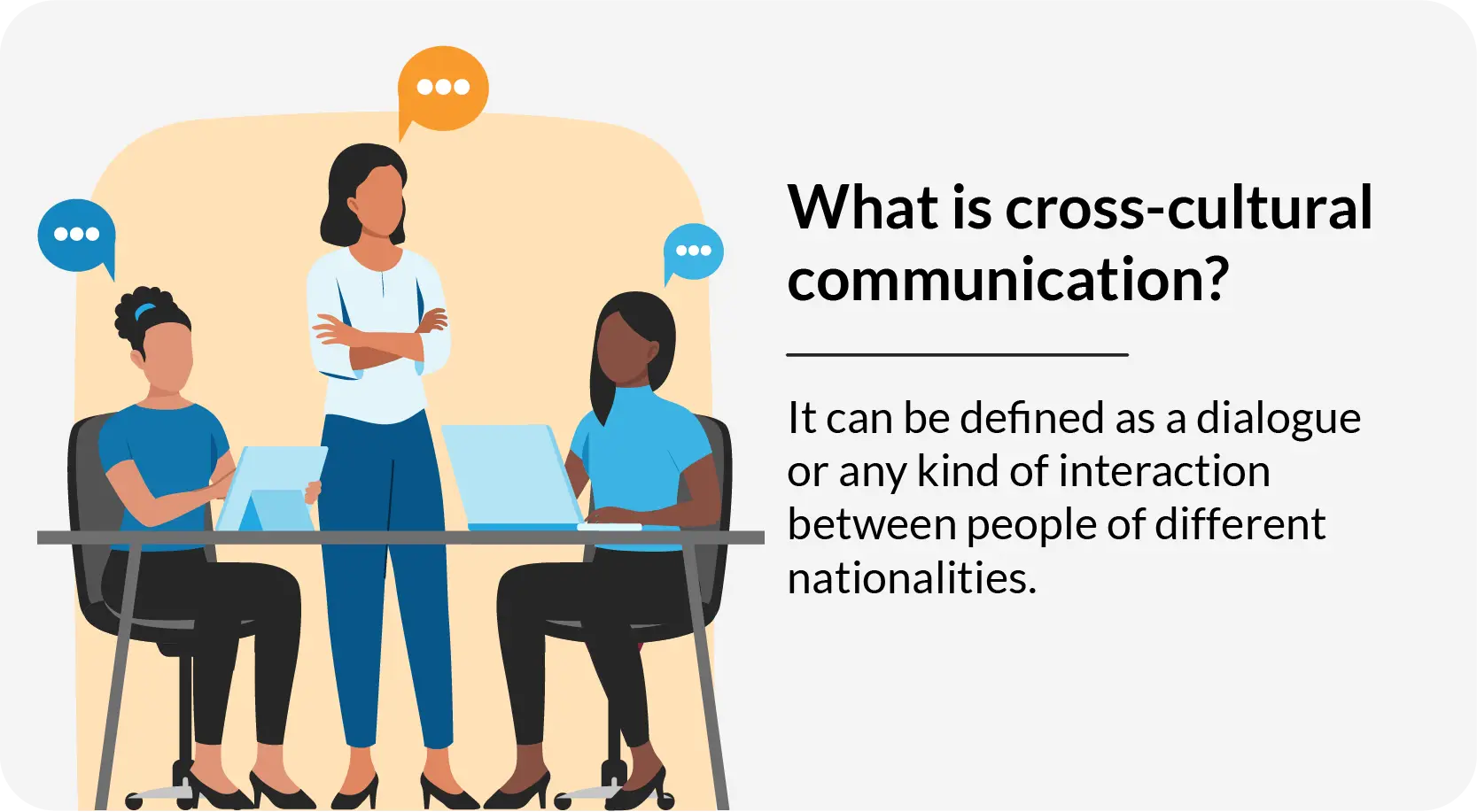Effective cross-cultural communication in the workplace: Key strategies for success

Cross-cultural communication in the workplace is essential for fostering collaboration, driving innovation, and ensuring that diverse teams thrive. Cross-cultural communication refers to how people from different cultural backgrounds interact, exchanging ideas, solving problems, and working towards common goals. As businesses become more multicultural, understanding and enhancing cross-cultural communication is critical for building a positive work environment and avoiding misconceptions.
This article will explore why cross-cultural communication is vital in the workplace, offering insights, strategies, and tips to help professionals communicate effectively across different cultures. If you’re looking to improve your team's communication skills, enhance collaboration, and bridge cultural differences, this article is for you.
What is cross-cultural communication in the workplace?
Cross-cultural communication in the workplace refers to the exchange of information between people from different cultural backgrounds within an organizational context. It involves understanding and respecting the differences and similarities among cultural groups, recognizing both verbal and nonverbal communication patterns, and fostering a positive working environment where everyone feels valued.
In a multi-cultural workplace, people from diverse backgrounds work together, often bringing varied approaches, viewpoints, and methods of doing things. This variety can lead to communication gaps or miscommunication if not managed properly. Understanding the cultural norms and communication styles of different groups is the first step in ensuring that collaboration is smooth and productive.
Effective cross-cultural communication enables organizations to maximize the strengths of their diverse teams, fostering innovation, enhancing problem-solving capabilities, and driving better decision-making. Communication is a key element in ensuring that the entire team, despite their different backgrounds, can work cohesively.

Importance of cross-cultural communication in workplace

Cross-cultural communication has become more important than ever in the modern business world due to the rise of globalization and multicultural teams. With employees from different countries working together, the ability to communicate across diversity is key to ensuring productivity, collaboration, and team harmony. Failure to understand cultural differences can lead to miscommunication, which may result in conflicts, reduced efficiency, and missed opportunities.
Moreover, cross-cultural communication plays a significant role in building strong relationships, both internally with colleagues and externally with clients or partners from other cultures. In competitive markets, understanding and adapting to different cultures and communication preferences can lead to better customer service and improved business outcomes.
Ultimately, the importance of cross cultural communication lies in its ability to promote mutual respect, enhance cooperation, and help organizations succeed in a diverse, globalized economy.
Common barriers to effective cross-cultural communication
There are several barriers that can hinder successful cross cultural communication in the workplace, including:
- Language differences: When people from different countries or backgrounds don’t speak the same language, the risk of miscommunication increases. Even when a common language is shared, linguistic nuances can still cause confusion.
- Cultural norms: Different groups may have distinct ways of conveying meaning, whether through nonverbal communication or specific cultural rituals. Ignoring these norms can lead to misconceptions or even offense.
- Stereotyping and bias: Preconceived notions about different cultures can create a barrier to open and respectful communication. It’s important to approach cross-cultural interactions with an open mind.
By addressing these challenges proactively, organizations can mediate cultural differences and ensure more harmonious workplace interactions.
Key strategies to improve cross-cultural communication in the workplace: Developing cross-cultural communication skills
Improving cross cultural communication in the workplace requires a proactive approach. Here are several communication strategies to consider:
- Encourage cultural awareness: Promote learning about the cultures represented in your team. Understanding the cultural norms of colleagues helps prevent miscommunication and fosters a more inclusive work environment.
- Develop active listening skills: Listening carefully is essential when communicating with people from different cultures. This helps to understand their points of view and avoid mistakes.
- Offer cross-cultural training: Implement training programs focused on improving cross-cultural communication. This can include workshops or seminars that teach employees how to navigate cultural differences in communication.
- Promote open dialogue: Encourage an environment where team members feel comfortable discussing cultural differences and sharing their experiences. This openness reduces the likelihood of misunderstandings and promotes stronger connections.
These strategies can help organizations improve cross-cultural communication and ensure a more effective and collaborative workplace.
How to implement cross-cultural communication programs in your organization
Implementing a structured cross-cultural communication program can greatly improve communication within your organization. Follow these steps:
- Assess the current situation: Evaluate how well your organization currently handles communication covering cultures. Identify areas where misunderstandings or miscommunication are common.
- Provide training: Offer workshops or training sessions focused on intercultural communication, teaching employees how to recognize and navigate cultural differences.
- Promote continuous learning: Encourage ongoing education about different backgrounds and methods of communication. Foster an open and curious approach to cross-cultural interactions.
- Monitor and adjust: Regularly review the success of your communication initiatives and make adjustments as needed. Solicit feedback from employees to ensure that the program remains relevant and effective.
By implementing these programs, organizations can ensure that they are effectively engaging employees from diverse backgrounds and maintaining productive communication channels.
Building a multicultural work culture
Creating a strong, inclusive work culture that supports cross-cultural communication is essential for fostering collaboration in diverse teams. Here are some steps organizations can take to build a multicultural workplace:
- Encourage cultural exchanges: Offer opportunities for employees to share their cultural traditions and perspectives. This can be done through formal presentations or informal conversations.
- Celebrate diversity: Recognize and celebrate the diversity within your workforce through events, cultural celebrations, and awareness initiatives. This can help promote understanding and respect for different cultures.
- Support leadership involvement: Leaders should model respectful communication and actively promote cross-cultural understanding in the workplace.
Building a multicultural work culture not only strengthens cross-cultural communication but also creates a more supportive and inclusive environment for all employees.
Frequently asked questions (FAQs)
1. What is effective communication, and why is it important in the workplace?
Effective communication refers to the clear and accurate exchange of information between people, ensuring that both the sender and receiver understand the message. It is essential in the workplace because it fosters collaboration, prevents misunderstandings, and helps teams work efficiently toward shared goals.
2. Why is cross-cultural communication important in a multicultural business environment?
Cross-cultural communication is important in a multicultural business environment because it ensures that team members from diverse backgrounds can interact effectively. It fosters mutual respect, reduces misunderstandings, and helps create a positive work culture where different cultured people can collaborate harmoniously.
3. How do cross-cultural barriers lead to conflicts between individuals or groups in the workplace?
Cross-cultural barriers such as language differences, misinterpretation of body language, or differing communication styles can lead to conflicts between individuals or groups. When people are unaware of these differences, misunderstandings arise, leading to tension and ineffective communication.
4. What role do communication strategies play in bridging cultural gaps?
Communication strategies designed to bridge cultural gaps involve active listening, empathy, and an understanding of other's cultures. These strategies help in adapting styles of communication to ensure that messages are understood across cultures, thereby promoting more effective and harmonious interactions.
5. Why is eye contact important in communication, and how does it vary across cultures?
Eye contact can signal confidence, interest, or sincerity in many cultures, but it is not universally understood in the same way. In some cultures, direct visual contact is considered respectful, while in others, it may be seen as rude or confrontational. Being aware of these cultural differences is key to fostering effective cross cultural communication.
Cross-cultural communication and presentations: Key tips
When delivering presentations across cultures, it's essential to tailor your approach to the communication styles and preferences of your audience. Here are some key strategies to ensure that communication is effective when addressing people from different backgrounds.
1. Use visual storytelling
Visuals transcend language barriers, making them crucial for multicultural communication. Clear images, simple graphics, and concise text can enhance understanding. Prezent offers templates and tools to help create visually impactful presentations that resonate across cultures.
2. Adapt your communication style
Recognize that styles of communication vary across cultures. Some audiences prefer direct approaches, while others may value subtlety. Tailor your content to match the preferences of people from different backgrounds to engage them effectively.
3. Focus on nonverbal communication
Nonverbal cues, like eye contact and gestures, carry different meanings in various cultures. For instance, frequent eye contact may be seen as confident in Western cultures but too direct in others. Being mindful of these differences can prevent misunderstandings
4. Encourage interaction
Invite your audience to engage by asking questions or offering feedback. This not only clarifies points but also helps people from different cultures interact, ensuring that all participants feel involved and respected in the conversation.
5. Recognize differences and similarities
Effective cross cultural communication involves recognizing both differences and similarities in how various cultures express themselves. By doing so, presenters can build a connection with a diverse audience while respecting their unique perspectives.
Prezent and Cross-Cultural presentations
Prezent’s AI-driven platform helps streamline presentations, making it easier to adjust content for diverse audiences. The platform offers customizable templates that accommodate linguistic and cultural variations, allowing you to present in ways that align with different cultural norms.
Incorporating these strategies will help you engage within a given context, ensuring smooth communication between individuals from different cultural backgrounds. Try it yourself with a free trial account or experience it with an demo with our expert leaders at your preferred time.



.avif)








